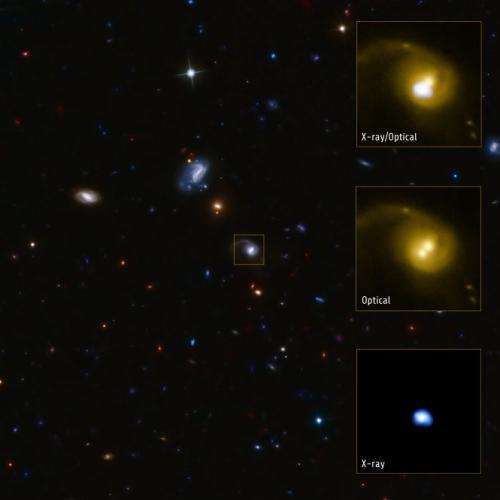A recoiling, supermassive black hole

When galaxies collide, the central supermassive black holes that reside at their cores will end up orbiting one another in a binary pair, at least according to current simulations. Einstein's general theory of relativity predicts that masses in a binary system should radiate gravitational waves, analogous to the way that accelerating electrical charges radiate electromagnetic waves but very much weaker.
As they radiate away their energy in these waves, orbiting black holes will gradually come closer together until eventually they merge in a coalescence event that is expected to emit a strong burst of gravitational waves. Relativity predicts that the gravitational radiation from black hole coalescence will be preferentially emitted in one direction that depends on the spin- and mass-ratios of the two black holes. In order to conserve momentum, therefore, the newly formed single supermassive black hole will recoil. Indeed, recoiling supermassive black holes are predicted to be one of the key observable signatures of such binary mergers. As they speed away from the center of the galaxy, they are expected to carry along with them their local environments (the discs and hot gas regions).
Amazingly, a few of these bizarre, recoiling candidates have apparently been serendipitously spotted (they are so far only candidates because their character is not yet confirmed). One of them is an X-ray source known as CID-42, which the Hubble Space Telescope resolves into two bright components only a few thousand light-years apart (a relatively small distance in galactic terms).
CfA astronomers Francesca Civano, Xiawei Wang, Avi Loeb, and Martin Elvis, together with their colleagues, used the Very Large Array radio facility to study the radio emission emitted by charged particles accelerated by the black holes in CID-42, and analyzed their data together with that from other facilities in an effort to confirm it as a recoil object. They find that all of the radio emission can be attributed to one of the two bright components, which also is the source of the X-ray emission. This source, their analysis concludes (although still not unequivocally), could indeed be a long-sought example of a recoiling black hole. The new research is a major step towards confirming the existence of these exotic objects, but further observations are still needed.
More information: "New Insights from Deep VLA Data on the Potentially Recoiling Black Hole CID-42 in the COSMOS Field," Mladen Novak, Vernesa Smolcic, Francesca Civano, Marco Bondi, Paolo Ciliegi, Xiawei Wang, Abraham Loeb, Julie Banfield, Stephen Bourke, Martin Elvis, Gregg Hallinan, Huib T. Intema, Hans-Rainer Klockner, Kunal Mooley and Felipe Navarrete, MNRAS, 447, 2282, 2015.
Provided by Harvard-Smithsonian Center for Astrophysics




















